1995 OLDSMOBILE SILHOUETTE light
[x] Cancel search: lightPage 282 of 390
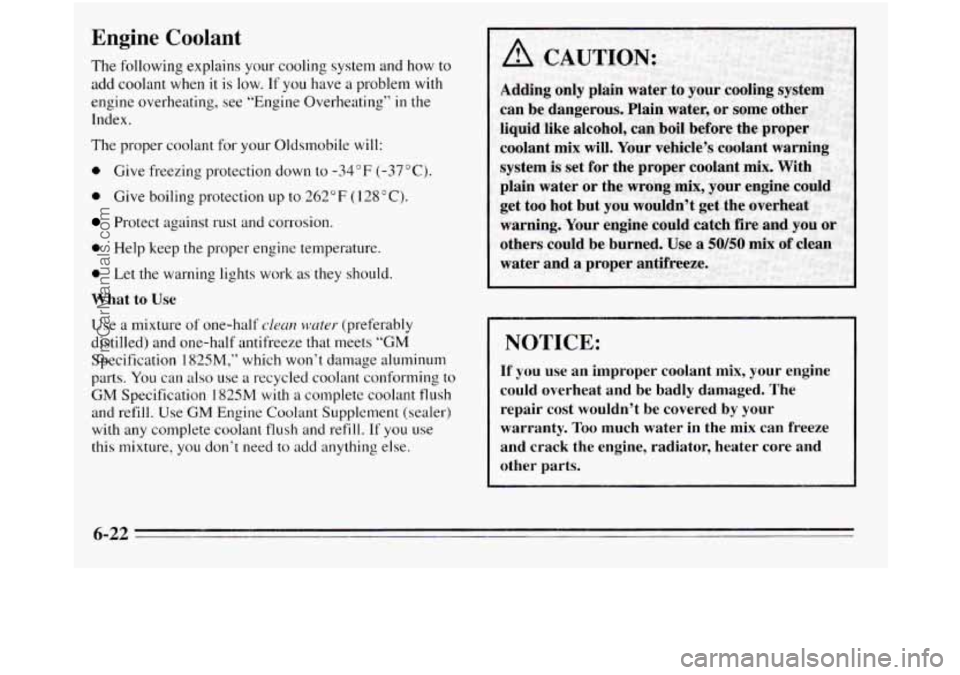
Engine Coolant
The following explains your cooling system and how to
add coolant when it is low.
If you have a problem with
engine overheating, see “Engine Overheating”
in the
Index.
The proper coolant for your Oldsmobile
will:
0 Give freezing protection down to -34°F (-37°C).
0 Give boiling protection up to 262 OF ( 128 ” C).
Protect against rust and corrosion.
0 Help keep the proper engine temperature.
0 Let the warning lights work as they should.
What to Use
Use a mixture of one-half clean water (preferably
distilled)
and one-half antifreeze that meets “GM
Specification
1825M,” which won’t damage aluminum
parts. You can also use a recycled coolant conforming to
GM Specification 1825M with a complete coolant flush
and refill. Use GM Engine Coolant Supplement (sealer)
with any complete coolant flush and refill.
If you use
this mixture,
you don’t need to add anything else.
NOTICE:
If you use an improper coolant mix, your engine
could overheat and be badly damaged.
The
repair cost wouldn’t be covered by your
warranty.
Too much water in the mix can freeze
and crack the engine, radiator, heater core and
other parts.
6-22
ProCarManuals.com
Page 288 of 390
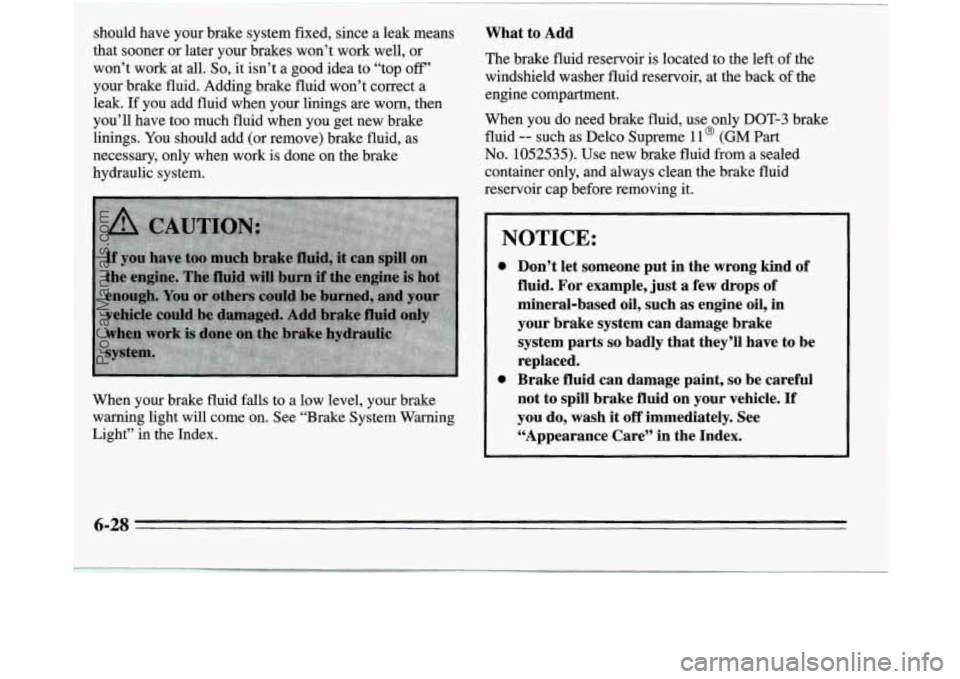
should have your brake system fixed, since a leak means
that sooner or later your brakes won’t work well, or
won’t work at all.
So, it isn’t a good idea to “top off’
your brake fluid. Adding brake fluid won’t correct a
leak. If you add fluid when your linings are worn, then
you’ll have too much fluid when you get new brake
linings. You should add (or remove) brake fluid, as
necessary, only when work is done on the brake
hydraulic system.
When your brake fluid falls to a low level, your brake
warning light will come on. See “Brake System Warning
Light” in the Index.
~~
~~~ ~~~ ~
What to Add
The brake fluid reservoir is located to the left of the
windshield washer fluid reservoir, at the back of the
engine compartment.
When you
do need brake fluid, use only DOT-3 brake
fluid
-- such as Delco Supreme 11 @ (GM Part
No. 1052535). Use new brake fluid from a sealed
container only, and always clean the brake fluid
reservoir cap before removin,g it.
-
NOTICE:
0 Don’t let someone put in the wrong kind of
fluid. For example, just a few drops of
mineral-based oil, such
as engine oil, in
your brake system can damage brake
system parts
so badly that they’ll have to be
replaced.
0 Brake fluid can damage paint, so be careful
not to spill brake fluid on your vehicle.
If
you do, wash it off immediately. See
“Appearance Care” in the Index.
6-28
ProCarManuals.com
Page 289 of 390
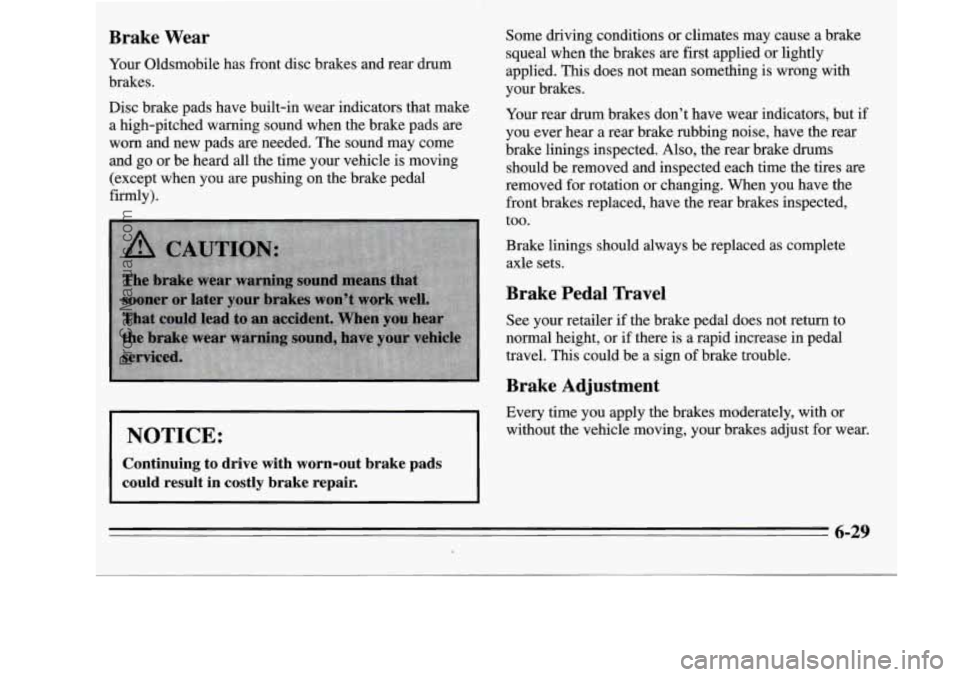
Brake Wear
Your Oldsmobile has front disc brakes and rear drum
brakes.
Disc brake pads have built-in wear indicators that make
a high-pitched warning sound when the brake pads are
worn and new pads are needed. The sound may come
and go or be heard
all the time your vehicle is moving
(except when you are pushing on the brake pedal
firmly).
NOTICE:
Continuing to drive with worn-out brake pads
could result in costly brake repair.
Some driving conditions or climates may cause a brake
squeal when the brakes are first applied or lightly
applied.
This does not mean something is wrong with
your brakes.
Your rear drum brakes don’t have wear indicators, but
if
you ever hear a rear brake rubbing noise, have the rear
brake linings inspected. Also, the rear brake drums
should be removed and inspected each time the tires are
removed for rotation or changing. When you have the
front brakes replaced, have the rear brakes inspected,
too.
Brake linings should always be replaced as complete
axle sets.
Brake Pedal Travel
See your retailer if the brake pedal does not return to
normal height, or if there is a rapid increase in pedal
travel.
This could be a sign of brake trouble.
Brake Adjustment
Every time you apply the brakes moderately, with or
without the vehicle moving, your brakes adjust for wear.
6-29
ProCarManuals.com
Page 303 of 390
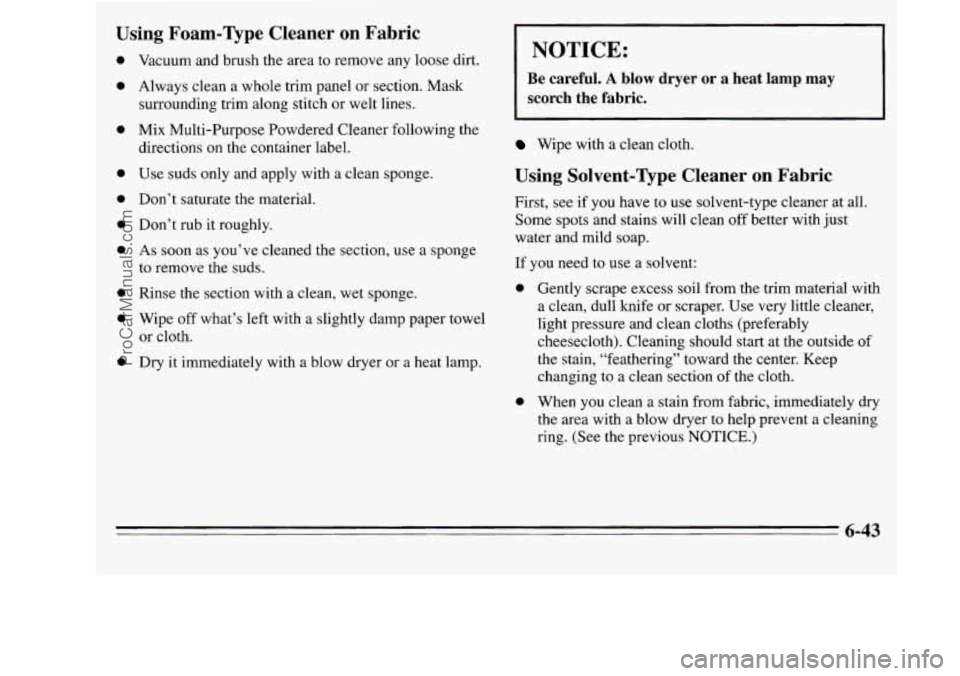
Using Foam-Type Cleaner on Fabric
0
0
0 0
0
0
Vacuum and brush the area to remove any loose dirt.
Always clean
a whole trim panel or section. Mask
surrounding trim along stitch or welt lines.
Mix Multi-Purpose Powdered Cleaner following the
directions
on the container label.
Use suds only and apply with a clean sponge.
Don’t saturate the material.
Don’t rub it roughly.
As soon as you’ve cleaned the section, use a sponge
to remove the suds.
Rinse the section with a clean, wet sponge.
Wipe off what’s left with a slightly damp paper towel
or cloth.
Dry it immediately with a blow dryer or a heat lamp.
NOTICE:
Be careful. A blow dryer or a heat lamp may
scorch the fabric.
i
Wipe with a clean cloth.
Using Solvent-Type Cleaner on Fabric
First, see if you have to use solvent-type cleaner at all.
Some spots and stains will clean off better with just
water and mild soap.
If you need to use a solvent:
0
0
Gently scrape excess soil from the trim material with
a clean, dull knife or scraper. Use very little cleaner,
light pressure and clean cloths (preferably
cheesecloth). Cleaning should start at the outside of
the stain, “feathering” toward the center. Keep
changing
to a clean section of the cloth.
When you clean a stain from fabric, immediately dry
the area with a blow dryer to help prevent a cleaning
ring. (See the previous NOTICE.)
6-43
ProCarManuals.com
Page 304 of 390
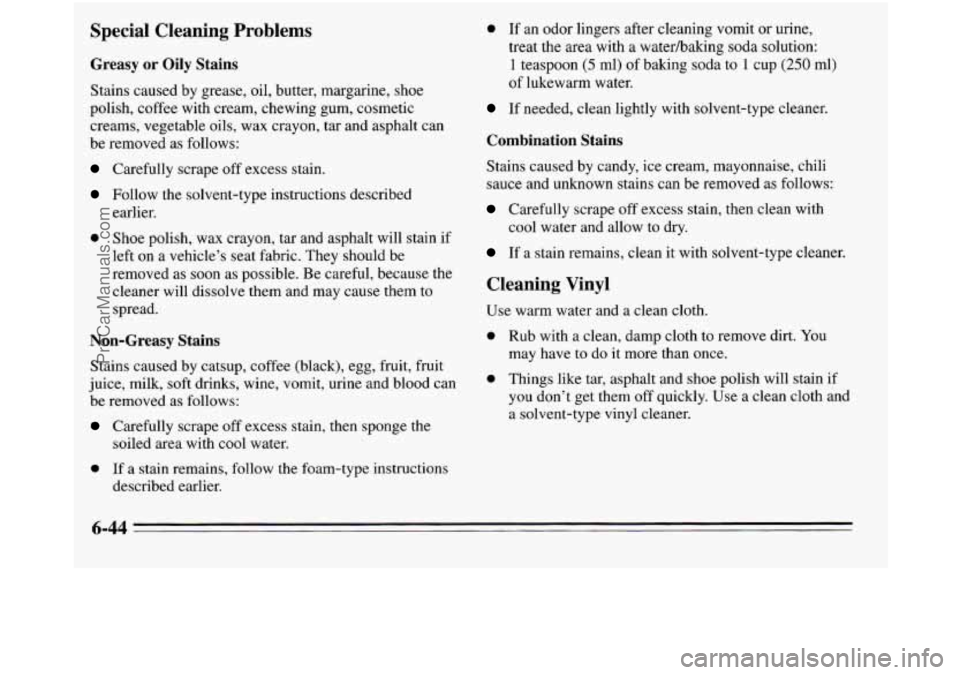
Special Cleaning Problems
Greasy or Oily Stains
Stains caused by grease, oil, butter, margarine, shoe
polish, coffee with cream, chewing gum, cosmetic
creams, vegetable oils, wax crayon, tar and asphalt can
be removed as follows:
Carefully scrape off excess stain.
Follow the solvent-type instructions described
earlier.
0 Shoe polish, wax crayon, tar and asphalt will stain if
left on
a vehicle’s seat fabric. They should be
removed as soon as possible. Be careful, because the
cleaner will dissolve them and may cause them to
spread.
Non-Greasy Stains
Stains caused by catsup, coffee (black), egg, fruit, fruit
juice, milk, soft drinks, wine, vomit, urine and blood can
be removed as follows:
Carefully scrape off excess stain, then sponge the
soiled area with cool water.
0 If a stain remains, follow the foam-type instructions
described earlier.
0 If an odor lingers after cleaning vomit or urine,
treat the area with
a waterhaking soda solution:
1 teaspoon (5 ml) of baking soda to 1 cup (250 ml)
of lukewarm water.
If needed, clean lightly with solvent-type cleaner.
Combination Stains
Stains caused by candy, ice cream, mayonnaise, chili
sauce and unknown stains can be removed as follows:
Carefully scrape off excess stain, then clean with
If a stain remains, clean it with solvent-type cleaner.
cool
water and allow to dry.
Cleaning Vinyl
Use warm water and a clean cloth.
0 Rub with a clean, damp cloth to remove dirt. You
may have to do it more than once.
0 Things like tar, asphalt and shoe polish will stain if
you don’t get them off quickly. Use a clean cloth and
a solvent-type vinyl cleaner.
6-44
ProCarManuals.com
Page 313 of 390

e
E5
c3
€3
ELC
HORN
E3 RDOllAUX
TAIL
El
c3
n
c3
ECM
TURN B/U
GAUGES LPS
ABS
E3 R WIPER
€5 HTRA/C
F WIPER
p-4 R BLW
Fuse Panel (3.1L V6 Engine)
Position Circuitry
CTSY Dome Lamps, Courtesy Lamps, Power Door
Lock Switches, Glove Box Lamp, Power
Mirrors, Power Sliding Delay Lock Module
ELC
HORN
STOP
HAZ Auto
Level Control, Underhood Lamp
Horns, Horn Relay, Safety Belt Buzzer
Front/Rear Turn Lamps, Front Sidemarker
Lamps, Rear Stop Lamps, Instrument Cluster
Turn Indicator Lamps, Cruise Brake Switch
F PUMP Fuel Pump,
Oil Pressure SenderIFuel Pump Switch
Position
RDO 1/
AUX
TAIL
ECM
TURN
B/U
GAUGES
LPS
ABS
RD02
R WIPER
F WIPER
IGN
HTR-A/C
R BLW
Circuitry
Radio, Front Cigar Lighter, Accessory Power
Outlet
Front Park Lamps, Rear Taillamps, Front
Sidemarker Lamps, License Plate Lamp, Radio,
HeatNentlAC Control Head, Power Sliding Door
Throttle Body Fuel Injection, Fuel Pump Relay,
Elec. Vac. Reg. Valve, Elec. Control Module,
Elec. Spark Control Module
Front/Rear Turn Lamps, Front Sidemarker Lamps, Cluster Turn Telltale, Back-up Lamps,
Fog Lamps
Cluster, Anti-Lock Brake System Lamp
Module, Elec. Level Control Sensor
Cluster, Radio, Wiper Switch, Headlamp
Switch, Rear Blower Switch, Heat/Vent/AC
Control Head, Door Switch Illumination,
FrontIRear Ashtray Illumination Bulbs
Anti-Lock Brake System
Radio
Rear Wiperwasher Motors; Overhead Console
Compass
Front Wipermasher Motor
A/C Compressor, A/C Solenoid Box, Compressor
Relay, Temp. Door Motor,
Low Blower Relay;
HeatNentlAC Control Head; Cruise Module; Cooling Fan Relay; Rear Defogger Relay;
Key
Chime; Vehicle Speed Sensor Buffer and Generator
Charge Discrete, Transaxle Converter Clutch Switch
FrondRear Blower Motors, High Blower Relay
Rear Blower, Rear Heat/Vent/AC
6-53
ProCarManuals.com
Page 314 of 390

Fuse Panel (3800 V6 Engine)
cCTSYI, ,fD023
eeC3
R WIPER
HORN TURN BIU F WIPER
r"4
STOP HA2
E5 TAIL
Position
CTSY
ELC
HORN
STOP
HAZ
Circuitry
Dome Lamps, Courtesy Lamps, Power Door
Lock Switches, Glove Box Lamp, Power
Mirrors, Power Sliding Delay Lock Module
Auto Level Control, Underhood Lamp
Horns,
Horn Relay, Safety Belt Buzzer
Front/Rear Turn Lamps, Front Sidemarker
Lamps, Rear Stop Lamps, Instrument Cluster
Turn Indicator Lamps
Position Circuitry
RDOl/ Radio, Front Cigar Lighter, Accessory Power
AUX Outlet
TAIL Front Park Lamps, Rear Taillamps, Front Sidemarker Lamps, License Plate Lamp, Radio,
HeatNentlAC Control Head, Power Sliding Door
ABS
ECM Anti-Lock
Brakemraction Control System
Mass Air How Sensor, Electronic Control Module
TURN Front/Rear Turn Lamps, Front Sidemarker
B/U Lamps, Cluster Turn Telltale, Back-up Lamps,
Fog Lamps
Module, Elec. Level Control Sensor
GAUGES Cluster, Anti-Lock
Brake System Lamp
INJ 3365D Remote Location (see page
6-56)
LPS Cluster, Radio, Wiper Switch, Headlamp
Switch, Rear Blower Switch, HeatNentlAC
Control Head, Door Switch Illumination,
Front/Rear Ashtray Illumination Bulbs
RD02 Radio
R WIPER Rear Wipermasher Motors; Overhead Console
F WIPER Front WiperNasher Motor
Compass
IGN A/C
Solenoid Box, Temp. Door Motor, Low
Blower Relay; HeatNentlAC Control Head;
Cooling Fan Relay; Rear Defogger Relay; Key
Chime; Transaxle Converter Clutch Solenoid
and Generator Charge Discrete
HTR-A/C Front/Rear Blower Motors, High Blower Relay
R BLW Rear Blower,
Rear HeatNentlAC
6-54
ProCarManuals.com
Page 377 of 390
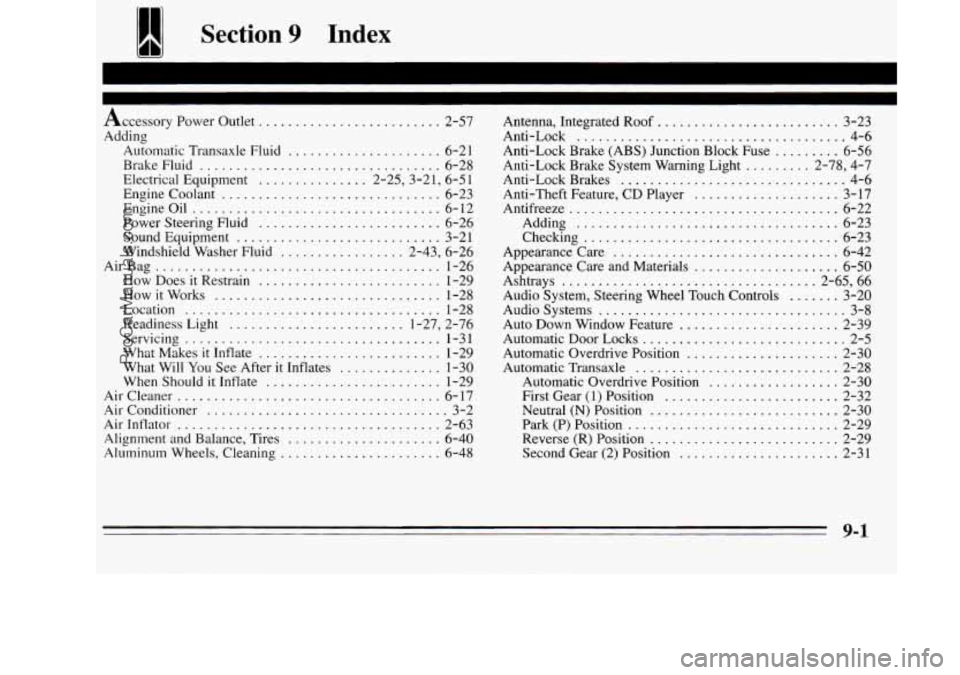
Section 9 Index
Accessory Power Outlet ......................... 2-57
Adding Automatic Transaxle Fluid
..................... 6-2 1
BrakeFluid ................................. 6-28
Electrical Equipment
............... 2.25.3.21. 6.51
Engine Coolant
.............................. 6-23
Engineoil
.................................. 6-12
Power Steering Fluid
......................... 6-26
SoundEquipment
............................ 3-21
Windshield Washer Fluid
................. 2.43. 6-26
AirBag
....................................... 1-26
How Does
it Restrain ......................... 1-29
How
it Works ............................... 1-28
Location
................................... 1-28
Readiness Light
........................ 1.27. 2.76
What Makes it Inflate
......................... 1-29
What Will You See After it Inflates
.............. 1-30
When Should
it Inflate ........................ 1-29
AirClealler
.................................... 6-17
Airconditioner
................................. 3-2
AirInflator
.................................... 2-63
Alignment and Balance. Tires
..................... 6-40
Aluminum Wheels. Cleaning
...................... 6-48
Servicing
................................... 1-31 Antenna.
Integrated Roof
......................... 3-23
Anti-Lock
..................................... 4-6
Anti-Lock Brake (ABS) Junction Block Fuse ......... 6-56
Anti-Lock Brake System Warning Light
......... 2.78. 4.7
Anti-Lock Brakes
............................... 4-6
Anti-Theft Feature. CD Player
.................... 3-17
Antifreeze
..................................... 6-22
Adding
.................................... 6-23
Checking
................................... 6-23
Appearance Care
............................... 6-42
Appearance Care and Materials
.................... 6-50
Ashtrays
................................... 2.65. 66
Audio Systems
.................................. 3-8
Auto Down Window Feature
...................... 2-39
Automatic Door Locks
............................ 2-5
Automatic Overdrive Position
..................... 2-30
Automatic Transaxle
............................ 2-28
Automatic Overdrive Position
.................. 2-30
First Gear (1) Position
........................ 2-32
Neutral
(N) Position .......................... 2-30
Park (P) Position
............................. 2-29
Reverse (R) Position
.......................... 2-29
Second Gear
(2) Position ...................... 2-31
Audio
System. Steering Wheel Touch Controls
....... 3-20
9-1
ProCarManuals.com